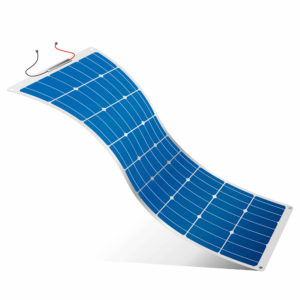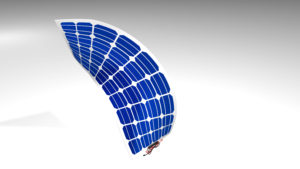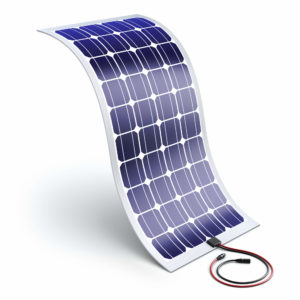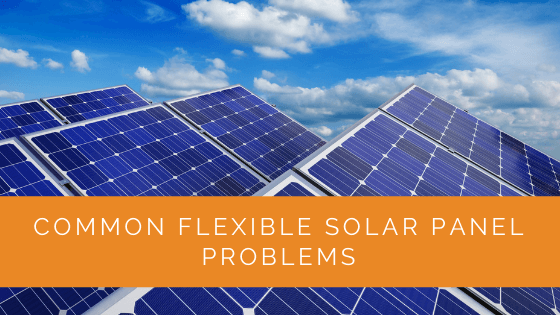Conventional solar panels might seem obstructive and limiting to some people. If you are one of them, you should consider installing flexible solar panels.
The adaptable construction of these panels offers many advantages over rigid solar panels.
Flexible solar panels make it easier for you to introduce renewable energy to your vessels and vehicles. Its pliable design lets it fit curved surfaces seamlessly. Many folks also prefer it for its lightweight nature.
Flexible solar panels do sound like a hit. But then, why are they not very popular?
It turns out that the flexibility is not enough to cover up for the downsides of these panels. Some common problems with flexible panels have kept their market limited.
So, let’s find out where these panels lag and if there’s any way to fix them!
Contents
What Are the Common Problems With Flexible Solar Panels?
Like all solar panel types, flexible solar panels, too, have both pros and cons. But it is those few drawbacks that keep many people from buying flexible solar panels.
Despite their versatility, lightweight nature, and budget-friendly price, people don’t view them as the best solar panel options. Unless flexibility is an absolute necessity, most people choose to invest in rigid solar panels.
So, let’s dig more and find out the persistent problems with flexible panels. Don’t worry; we’ll also help you find a solution to each issue!
Poor Efficiency
Compared to rigid solar panels, flexible solar panels’ efficiency might feel lacking. The rigid crystalline solar panels boast an efficiency between 16% and 23%. On the other hand, flexible solar panels only offer an efficiency rate of 10% to 17%.
This lack of efficiency is partly because of the thin semiconductor film. Flexible solar panels feature thin semiconductor films that don’t have enough material to react with sunlight.
Besides, the semiconductor material in flexible solar panels is less efficient than the crystalline silicon in rigid solar panels.

How to Fix This
The only solution to this problem is to opt for a better-quality product. Make sure to buy top-notch flexible solar panels with outstanding performance.
So, if flexible panels are necessary, you’re better off paying more for the best quality. Another fix to this efficiency problem is adding more panels. But this solution requires adequate space.
The good news is that these panels are lightweight. So even if you have to install more flexible panels, it won’t pressure your roof.
We recommend you to spend time and consider your choices. Research on better flexible solar panels is in place. Shortly, you may even have flexible solar panels with high levels of efficiency.
Prone to Damage
It’s natural for all of us to take flexible panels for granted when it comes to durability. After all, they can bend, right? However, too much flexing and bending can cause the solar panels to crack.
If you have installed flexible solar panels on your truck, RV, or house, branches of trees can scratch the thin plastic. It might damage the solar cells. One bad bump can significantly lower your solar panels’ efficiency.
On the other hand, rigid solar panels have a glass covering. This glass covering offers much better protection to solar cells.
How to Fix This
The solution to the problem is more straightforward than it looks. You have to take better care of your panels!
If you want your panels to live longer, don’t fold or bend them more than required. Though these solar panels have a design that can take a good beating, the internal components are still sensitive.
The electronics and semiconductors in the solar panels are prone to damage. If you install the flexible panel on your vehicle, be careful of low-lying branches. Also, do not stand or walk on the solar panels.
The flexible solar panels easily blend with your roof, owing to their adaptable structure. Hence, you’ll need to watch your step to avoid damaging them.
Lack of Durability
The working period of these flexible panels is much shorter than that of their rigid counterparts. The rigid solar panels can provide outstanding service of at least 25 to 40 years.
Unfortunately, flexible solar panels can only function for 15 to 25 years at their best.
Even during their initial days, the efficiency of the flexible solar panels is relatively low. So, as they become old, their efficiency drops even lower. As a result, they won’t stay effective for very long.
The low efficiency of the solar panels is directly related to durability. Since these flexible solar panels have more recreational applications, their likelihood of getting damaged is higher.
How to Fix This
The simplest way to ensure a long lifespan for these solar panels is to maintain them well. Keep your flexible solar panels free from dust and dirt. Make sure to handle them with utmost care.
Again, be mindful of your steps, and don’t walk over these panels. Also, be extra cautious when you drive your solar panel-installed vehicle through woody areas.
Those microcracks might not look like a concern initially. But, they’ll allow more dust and debris to infiltrate. Even the slightest crack will result in lower power output, significantly bringing down the lifespan.
Another way to fix this is to buy quality flexible solar panels. Some high-end flexible solar panels offer the same lasting as rigid solar panels.
Short Warranties
Since flexible solar panels are easily prone to damage, they tend to have a shorter shelf life. What’s more, this usually results in manufacturers offering a limited warranty period on these solar panels.
Flexible solar panels companies don’t wish to take the risk of offering a warranty for flexible solar panels. In contrast, manufacturers offer a whopping 25-year warranty on rigid solar panels.
For flexible solar panels, the warranty period tends to range between 15 and 20 years. Hence, these short warranties don’t act as great incentives for buyers.
How to Fix This
If you don’t want to risk repair charges and irreparable damages, you should take better care of your solar panels. The only way to beat short warranties is to ensure your panels are maintained well.
Flexible solar panels might have a short warranty period but can easily last another ten years with reasonable care.
It is also worth mentioning that high-quality solar panels tend to last longer. As a result, the manufacturers might offer more extended warranties with them.
Toxicity
Not all flexible solar panels are toxic. However, some manufacturers do use poisonous materials to produce flexible solar panels. The use of CIGS and CdTe in flexible solar panels is the cause of their toxicity.
CdTe contains cadmium, which is carcinogenic and highly toxic. The workers who produce CdTe panels have the highest health risks. Customers might also face health repercussions with these panels.
Exposure to broken panels and the semiconductor material within it can potentially result in health problems. The same applies to CIGS solar panels. But, the toxicity levels are much lower for CIGS cells.
Consequently, both these materials are harmful to the environment. Without proper disposal, the toxic chemicals can leach into the water and soil.
Some flexible and rigid solar panels use silicon as their semiconductor material. This material, too, imposes a threat to wildlife, people, and the environment.

How to Fix This
Copper Indium Gallium Selenium (CIGS) and Cadmium Telluride (CdTe) are some of the most efficient semiconductor materials on the market. Therefore, many people prefer these materials over flexible silicon solar panels.
If you consider installing flexible solar panels with these materials, it is imperative to understand the risks. Maintaining these solar panels well is very important.
Thankfully, only severe damage can lead to the panel exposing its toxic materials. Slight cracks and damages don’t pose as much danger.
It is also crucial that you treat them as hazardous waste at the time of their disposal. Though this rule applies to all solar panels, it is mandatory for CIGS and CdTe solar panels.
Many specific solar panel recycling programs deal with these toxic materials. They ensure that the material undergoes proper reuse or disposal. If you don’t want to risk installing hazards on your roof, flexible silicon is your safest bet.
Delamination and UV Degradation
The flexible solar panels spend all day in the sun. Unfortunately, after a period, the powerful UV rays cause chemical changes in the panel. If you have cheap or low-quality solar panels, UV-degradation is unavoidable.
It is true for both rigid and flexible solar panels. You can spot signs of UV damage when the plastic laminate on your flexible panels looks cloudy and yellow.
The discoloration of plastic laminate blocks the sunlight and reduces efficiency. If the situation turns worse, your panels might even undergo delamination. Delamination occurs when the plastic laminates detach from the solar cells.
Panels with delamination do not have much scope. The only way to deal with delaminated panels is through disposal.
How to Fix This
If you want a solution to this problem, the only thing we can suggest is installing high-quality flexible panels!
Degradation and delamination are expected only with a low-quality plastic material such as PET. It will help if you look for high-quality solar panels that use durable plastic materials such as ETFE. It can tackle delamination and degradation.
What’s more, ETFE plastic is 100% recyclable and self-cleaning. In case you are on a budget, you should consider only high-quality flexible solar panels. Trying to save money with cheap solar panels will cost you more in the future.
The Hotspots
Flexible solar panels find more installations on roofs and walls. In general, the positioning of the flexible solar panels does not offer them much room to cool down.
Rigid solar panels also come with mountable racks, which allows them to cool. Though the solar panels are designed to perform under the sun, the scorching weather can damage solar cells.
The temperature within the solar cells can shoot up to very high levels. As a result, it can lead to hotspots within the solar panel. These hotspots reduce efficiency dramatically.
That’s not it; hotspots can even augment delamination and UV damage. Temperature fluctuations within solar cells might also lead to microcracks. All these can result in shortened shelf life and reduced efficiency.

How to Fix This
High-quality panels again come to your rescue!
Flexible solar panels that use PET plastic are susceptible to high temperatures. Delamination is a common occurrence in low-quality plastic panels. Investing more money in ETFE will ensure lasting benefits.
Another thing you can do is practice a good maintenance routine for your solar panels. By cleaning and keeping the panels free from debris, you can keep up their game.
Chemical Degradation
If you live near the ocean or have flexible panels installed on your boat, chemical degradation can become a problem.
The constant ocean spray and barrage of salty air can build on the plastic and erode it. Eventually, it’ll damage the solar cells and reduce their efficiency.
Besides, if the water panels are often wet, the water can magnify the UV rays and fast-track degradation.
How to Fix This
Again, quality is the key. PET plastic is not capable of handling harsh coastline or ocean conditions. On the other hand, ETFE solar panels can sustain the marine environment and salty air.
Unlike PET panels, ETFE panels don’t suffer from cloudiness or discoloration. If you are looking to equip your boat with flexible solar panels, go for the high-quality ones.
Why You Should Buy Flexible Solar Panels
You might be reconsidering your decision to buy flexible solar panels. It’s natural to be wary of them after spotting their shortcomings. However, that doesn’t mean you have to discard the idea of flexible solar panels entirely.
Even with their drawbacks, these solar panels offer excellent applications in some situations. Their ability to bend on curved surfaces and flexible structures make them suitable for boats and RVs.
If you are looking for an aesthetically pleasing solar array for your vehicle, flexible solar panels make a perfect choice.
Plus, if you require something lightweight, flexible solar panels can help you with that too. In the future, flexible solar panels might even contribute to space exploration projects.
Flexible solar panels have quite a few downsides. But, be it rigid or flexible, all solar panels have strengths and weaknesses. You can avoid most of the flexible solar panel problems by ensuring a high-quality purchase.
Maintenance also plays a massive role in the performance of flexible panels. Keep the dirt and grime off, and they’ll work well.
Though they bend, you should be extra cautious while tackling them. Flexible solar panels happen to be more delicate than usual panels.
Hence, take care of your flexible solar panels, and they will take care of you!
Expert Insights From Our Solar Panel Installers About Common Flexible Solar Panel Problems and How to Fix Them
Flexible solar panels are a great solution for non-traditional surfaces, but their efficiency can be a concern. Choosing higher-quality panels can mitigate many of the efficiency issues commonly seen.
Senior Solar Technician
One of the main challenges with flexible solar panels is their vulnerability to physical damage. Ensuring proper installation and minimal bending can significantly extend their lifespan.
Lead Solar Installer
Maintenance is key to the longevity of flexible solar panels. Regularly cleaning and avoiding unnecessary flexing can help maintain their efficiency and durability over time.
Solar Maintenance Specialist
Wrapping Up
You now know how and where flexible solar panels lack. Though these solar panels have some drawbacks, the suggested fixes should do the trick. Their ability to fit many types of solar projects is one of their most significant advantages.
You should know that flexible solar panels also reduce the financial burden as the installation costs are generally low. Unlike conventional solar panels, flexible solar panels are more apt for RVs and vessels.
We hope this article has helped you understand the common problems with flexible panels and immediate fixes. So, have you made up your mind to install flexible solar panels?
About the Author
Solar Panels Network USA stands at the forefront of solar energy solutions, driven by a team of seasoned solar engineers and energy consultants. With over decades of experience in delivering high-quality solar installations and maintenance, we are committed to promoting sustainable energy through customer-centric, tailored solutions. Our articles reflect this commitment, crafted collaboratively by experts to provide accurate, up-to-date insights into solar technology, ensuring our readers are well-informed and empowered in their solar energy decisions.

